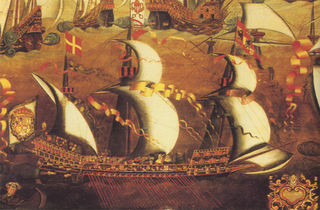 W
WAmazone was a 32-gun Iphigénie-class frigate of the French Navy. She was the second ship of the French Navy to receive a copper sheathing in 1778. She served in the War of American Independence under Captain Lapérouse, and later in the French Revolutionary Wars.
 W
WDainty was an English race-built galleon that began to be built in 1588. The original name was Repentance, but this was soon changed. She participated in some naval engagements in the Anglo-Spanish War (1585–1604). In 1593 she sailed from England under Richard Hawkins to navigate the Pacific Ocean and circumnavigate the world, but was captured the following year by the Spaniards when she was sailing off the coast of what is now Ecuador. She was commissioned by the Spaniards as Nuestra Señora de la Visitación, serving in the South Pacific for several years.
 W
WThe Descubierta and Atrevida were twin corvettes of the Spanish Navy, custom-designed as identical special exploration and scientific research vessels. Both ships were built at the same time for the Malaspina Expedition. Under the command of Alessandro Malaspina (Descubierta) and José de Bustamante y Guerra (Atrevida) the two vessels sailed from Spain to the Pacific Ocean, conducting a thorough examination of the internal politics of the American Spanish Empire and the Philippines. They explored the coast of Alaska and worked to reinforce Spain's claim to the Pacific Northwest in the aftermath of the Nootka Crisis. After crossing the Pacific Ocean, the government in the Philippines examined. Exploration and diplomatic reconnaissance followed, with stops in China, New Zealand, Australia, and Tonga.
 W
WThe El Cazador was a Spanish brig that sank in the Gulf of Mexico in 1784. In the 1770s the Spanish Louisiana Territory’s economy was faltering due to paper money that was not backed by silver or gold. Carlos III, King of Spain, decided to replace the worthless currency with valuable Spanish silver coins. On 20 October 1783 Charles III of Spain sent her on a mission to bring much-needed hard currency to the Spanish colony of Louisiana in order to stabilize the currency. The ship sailed to Veracruz, Mexico, where she was loaded with approximately 450,000 Spanish reales. To be more precise, she was loaded with silver Spanish coins, mostly 8 reales, “Pieces of Eight,” It carried 400,000 silver pesos and another 50,000 pesos worth of smaller change, of various dates. At one ounce to the peso, and 12 troy ounces to the pound, that's 37,500 pounds of silver. King Carlos III enlisted his most trusted captain, Gabriel de Campos y Pineda, to command the ship. On 11 January 1784, she sailed for New Orleans, and was never heard from again. Spain’s attempts to locate the ship were unsuccessful and in June 1784, El Cazador was officially listed as missing at sea.
 W
WLa Girona was a galleass of the 1588 Spanish Armada that foundered and sank off Lacada Point, County Antrim, on the night of 26 October 1588, after making its way eastward along the Northern Irish coast. The wreck is noteworthy for the great loss of life that resulted and the treasures recovered.
 W
WThe Mexicana was a topsail schooner built in 1791 by the Spanish Navy at San Blas, New Spain. It was nearly identical to the Sutil, also built at San Blas later in 1791. Both vessels were built for exploring the newly discovered Strait of Georgia, carried out in 1792 under Dionisio Alcalá Galiano, on the Sutil, and Cayetano Valdés y Flores, on the Mexicana. During this voyage the two Spanish vessels encountered the two British vessels under George Vancouver, HMS Discovery and Chatham, which were also engaged in exploring the Strait of Georgia. The two expeditions cooperated in surveying the complex channels between the Strait of Georgia and Queen Charlotte Strait, in the process proving the insularity of Vancouver Island. After this first voyage the Mexicana continued to serve the San Blas Naval Department, making various voyages to Alta California and the Pacific Northwest coast.
 W
WThe galleon San Diego was built as the trading ship San Antonio before hastily being converted into a warship of the Spanish Navy. On December 14, 1600, the fully laden San Diego was engaged by the Dutch warship Mauritius under the command of Admiral Olivier van Noort a short distance away from Fortune Island, Nasugbu, Philippines. Since San Diego couldn't handle the extra weight of her cannons, which led to a permanent list and put the cannon portholes below sea level, she was sunk without firing a single shot in response. The Dutch were later reported firing upon and hurling lances at the survivors attempting to climb aboard the Mauritius.
 W
WSan José was a 64-gun, 3-masted galleon of the Spanish Navy. It was launched in 1698, and sank in battle off the coast of Cartagena, Colombia, in 1708 while laden with gold, silver and emeralds worth about US$17 billion as of 2018. The sunken ship was located by the Woods Hole Oceanographic Institution (WHOI) in November 2015.
 W
WSutil was a brig-rigged schooner built in 1791 by the Spanish Navy at San Blas, New Spain. It was nearly identical to Mexicana, also built at San Blas in 1791. Both vessels were built for exploring the newly discovered Strait of Georgia, carried out in 1792 under Dionisio Alcalá Galiano, on Sutil, and Cayetano Valdés y Flores, on Mexicana. During this voyage the two Spanish vessels encountered the two British vessels under George Vancouver, HMS Discovery and HMS Chatham, which were also engaged in exploring the Strait of Georgia. The two expeditions cooperated in surveying the complex channels between the Strait of Georgia and Queen Charlotte Strait, in the process proving the insularity of Vancouver Island. After this first voyage Sutil continued to serve the San Blas Naval Department, making various voyages to Alta California and the Pacific Northwest coast.